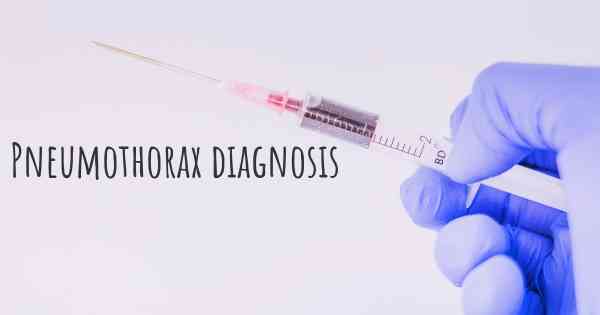How is Pneumothorax diagnosed?
See how Pneumothorax is diagnosed. Which specialists are essential to meet, what tests are needed and other useful information for the diagnosis of Pneumothorax

Pneumothorax is a medical condition characterized by the presence of air or gas in the pleural cavity, the space between the lungs and the chest wall. This condition can cause the lung to collapse partially or completely, leading to various symptoms and potential complications. Diagnosing pneumothorax involves a combination of clinical evaluation, medical history assessment, and diagnostic tests.
Clinical Evaluation
During the clinical evaluation, a healthcare professional will perform a physical examination to assess the patient's symptoms and signs. They will listen to the patient's breathing using a stethoscope, looking for abnormal breath sounds such as decreased or absent breath sounds on the affected side. The presence of respiratory distress, chest pain, or sudden onset of shortness of breath may also be indicative of pneumothorax.
Medical History Assessment
Obtaining a detailed medical history is crucial in diagnosing pneumothorax. The healthcare provider will inquire about the patient's symptoms, their duration, and any potential triggers or underlying conditions. It is important to mention any history of lung diseases, previous pneumothorax episodes, recent trauma or injury to the chest, or any medical procedures involving the chest area.
Diagnostic Tests
Several diagnostic tests can aid in confirming the presence of pneumothorax:
1. Chest X-ray:
A chest X-ray is often the initial diagnostic test performed to evaluate suspected pneumothorax. It can reveal the presence of air in the pleural cavity and help determine the extent of lung collapse. On the X-ray image, a visible dark area between the lung and chest wall may indicate the presence of pneumothorax. However, small or subtle pneumothoraces may be challenging to detect on a chest X-ray.
2. Computed Tomography (CT) Scan:
A CT scan provides more detailed images of the chest compared to a chest X-ray. It can help identify smaller pneumothoraces that may not be visible on an X-ray. CT scans are particularly useful when the diagnosis is uncertain or when complications such as pneumothorax-related lung damage or underlying lung diseases are suspected.
3. Ultrasound:
Ultrasound imaging is a non-invasive and readily available tool that can be used to diagnose pneumothorax. It involves using high-frequency sound waves to create real-time images of the chest. An ultrasound can detect the presence of air or fluid in the pleural cavity and help guide certain procedures, such as thoracentesis (removal of fluid from the pleural space) or chest tube placement.
4. Arterial Blood Gas (ABG) Analysis:
An ABG analysis involves taking a blood sample from an artery to measure the levels of oxygen and carbon dioxide. In cases of pneumothorax, ABG analysis may reveal decreased oxygen levels and increased carbon dioxide levels, indicating respiratory distress and impaired lung function.
5. Pulse Oximetry:
Pulse oximetry is a non-invasive test that measures the oxygen saturation level in the blood. It involves placing a small sensor on a finger or earlobe. In pneumothorax cases, pulse oximetry may show decreased oxygen saturation due to impaired lung function.
6. Needle Aspiration:
In some cases, when the diagnosis is uncertain or urgent treatment is required, a needle aspiration may be performed. This involves inserting a needle into the pleural cavity to withdraw air or fluid for analysis. Needle aspiration can help confirm the presence of pneumothorax and relieve symptoms if necessary.
It is important to note that the specific diagnostic approach may vary depending on the individual patient, the severity of symptoms, and the available resources. A combination of these diagnostic tests, along with a thorough clinical evaluation and medical history assessment, is typically employed to diagnose pneumothorax accurately.








